The Haswell Review: Intel Core i7-4770K & i5-4670K Tested
by Anand Lal Shimpi on June 1, 2013 10:00 AM ESTCPU Performance: Five Generations of Intel CPUs Compared
For the purposes of our look at Haswell, we will be breaking up our review coverage into two parts. The rest of this article will focus on the CPU side of Haswell, while coverage of the GPU - including Iris Pro and Crystalwell - has been spun off into another artice: Intel Iris Pro 5200 Graphics Review: Core i7-4950HQ Tested.
The majority of the market doesn’t upgrade annually, so I went back a total of five generations to characterize Haswell’s CPU performance. Everything from a 2.53GHz Core 2 Duo through Nehalem, Sandy Bridge, Ivy Bridge and Haswell are represented here. With the exception of the Core 2 platform, everything else is running at or near the peak launch frequency for the chip.
In general, I saw performance gains over Ivy Bridge of 1 - 19%, with an average improvement of 8.3%. Some of the performance gains were actually quite impressive. The 7.8% increase in Kraken shows there’s still room for improvement in lightly threaded performance, while the double digit FP performance gains in POV-Ray and x264 HD really play to Haswell’s strengths.
Compared to Sandy Bridge, Haswell looks even more impressive. The Core i7-4770K outperforms the i7-2700K by 7 - 26%, with an average performance advantage of 17%. The gains over Sandy Bridge aren’t large enough to make upgrading from a Sandy Bridge i7 to a Haswell i5 worthwhile though, as you still give up a lot if you go from 8 to 4 threads on a quad-core part running heavily threaded workloads.
Compared to Nehalem the gains average almost 44%.
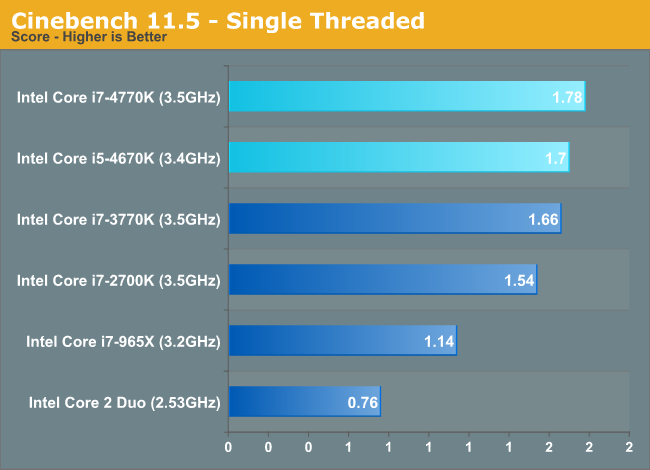


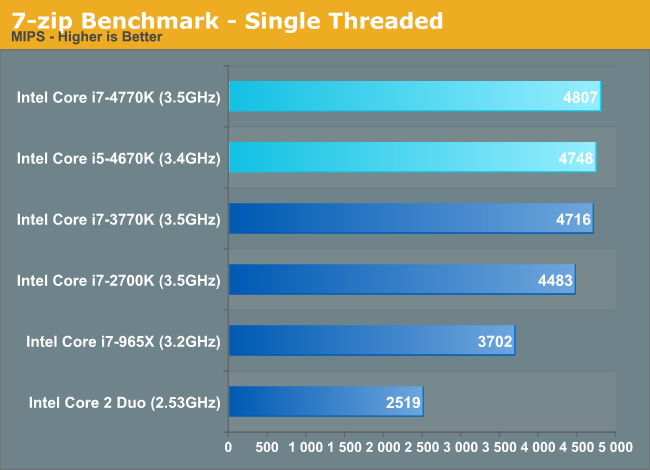
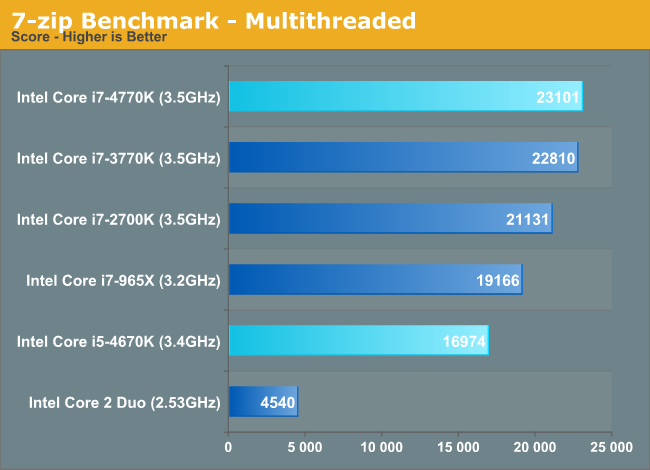
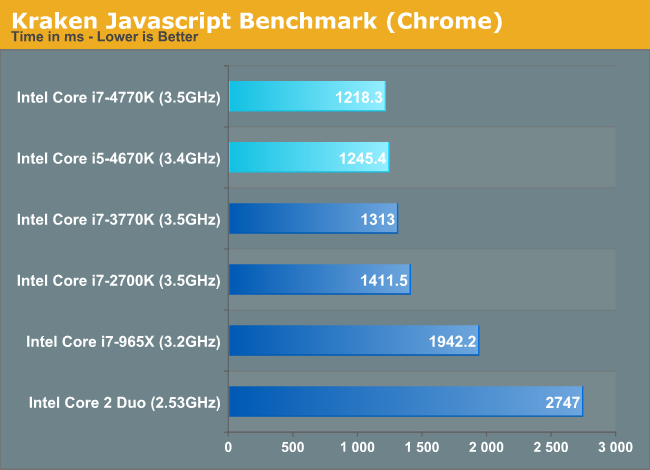
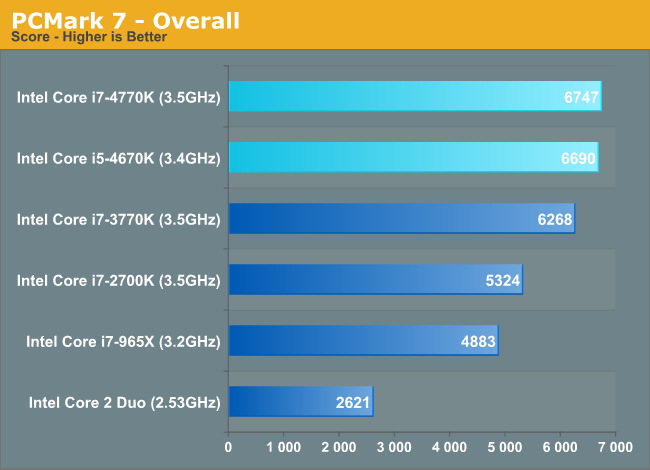
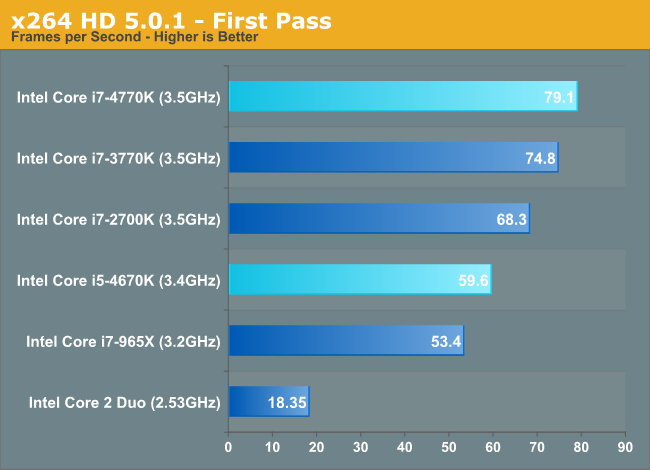
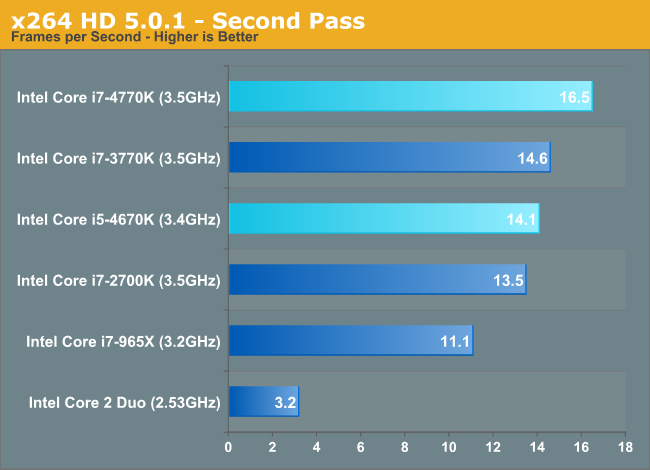
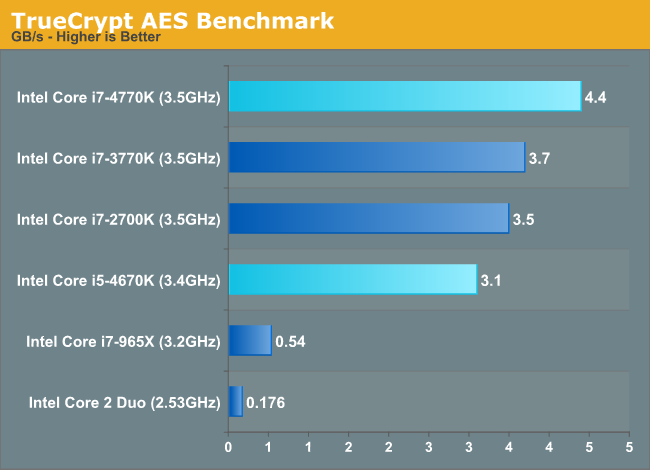

Quite possibly the most surprising was just how consistent (and large) the performance improvements were in our Visual Studio 2012 compile test. With a 15% increase in performance vs. Ivy Bridge at the same frequencies, what we’re looking at here is the perfect example of Haswell’s IPC increases manifesting in a real-world benchmark.
Gaming Performance
After spending far too much time on the Iris Pro test system, I didn’t have a ton of time left over to do a lot of gaming performance testing with Haswell. Luckily Ian had his gaming performance test data already in the engine, so I borrowed a couple of graphs.
As expected, Haswell is incrementally quicker in GPU bound gaming scenarios compared to Ivy Bridge - and most definitely at the top of the charts.
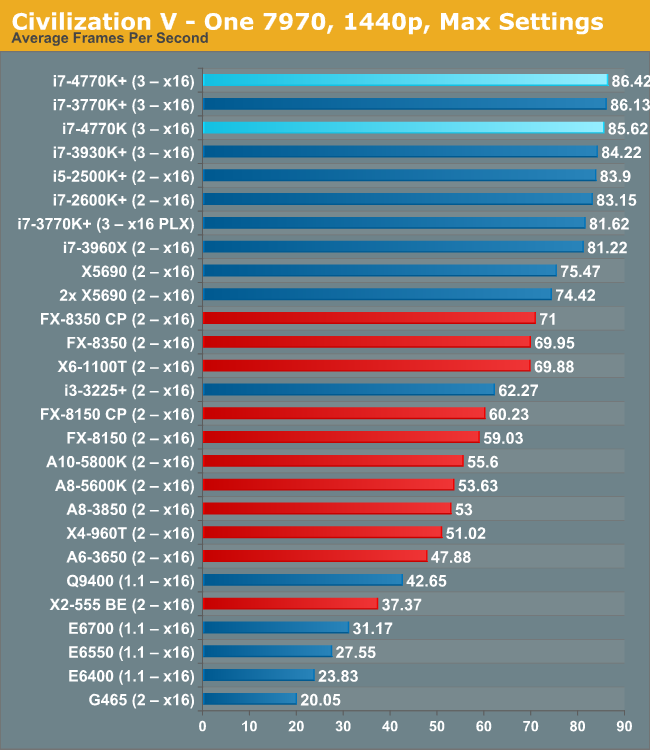











210 Comments
View All Comments
AmdInside - Sunday, June 2, 2013 - link
I am actually more interested in the new 8 series chipsets than Haswell. I have a Sandybridge work desktop and Ivybridge gaming desktop and would switch my Sandybridge motherboard if the chipset were backwards compatible with SB CPUs.Klimax - Sunday, June 2, 2013 - link
Just reminder: We are more or less out of free performance without new algorithms or massive complexity/power consumption. (There are limits to what we can do)And Intel engineers won't increase complexity of chips. (Otherwise they'd have their own version of GPU problems)
Anyway, waiting for Haswell-E... (Could use AVX2, but don't wont to lose 6 cores of 3930k)
ashetosvlakas - Sunday, June 2, 2013 - link
"As we’ve seen in the past, the K-series parts (and now the R-series as well) omit support for vPro, TXT, VT-d, and SIPP from the list."As this is the official Haswell review and since TSX are not included in the K-series parts, I believe this is a huge omission from the review, especially since transactional memory is a revolutionary technology with a lot of potential. I find the lack of mention misleading and it should be corrected as soon as possible.
KAlmquist - Sunday, June 2, 2013 - link
Thanks for letting us know this. Checking the specifications on ark.intel.com, I find:i5-4430 no TSX
i5-4570 has TSX
i5-4670 has TSX
i5-4670K no TSX
i7-4770 has TSX
i7-4770K no TSX
So TSX is missing from half of the current Haswell models (ignoring the low power S and T chips). So far we only have quad core chips; I expect that TSX will be missing from most of the dual core chips. It doesn't seem that TSX is intended to be used by developers writing general purpose code.
Kougar - Sunday, June 2, 2013 - link
Is 2016 the earliest we will see Haswell-E launch?Buying a 4770K means I'm wasting 33% of the die on a GPU I don't want, and because it's a "K" chip it will also lose VT-d capability. Six-core "K" chips retain VT-d support, but buying SB-E seems silly given Haswell offers much better IPC and single-threaded performance, and later even against IB-E it would feel like paying more for less.
Intel has taken a perpetual 2-year break between updating its high end, so if IB-E launches Q4'13 then it seems Q4'15 would be the earliest Haswell-E will show up?
Charlesm1950 - Sunday, June 2, 2013 - link
Haswell GT3e graphics come at what price? Certainly a lot more than Haswell GT2 or Richland A10 graphics. And Intel is right, Haswell GT3e graphics beats old, entry level discrete graphics cards. BUT, Haswell does not do DUAL GRAPHICS! Pair a Haswell with a dGPU and you get only the graphics horsepower of the dGPU. In short, you waste all that die area that Intel devoted to GT3e and eDRAM. On the other hand, pair a AMD Richland A10 with a dGPU and both GPUs work in tandem to give performance scores well beyond Haswell GT3e and for dare I say a lot less money. That's true even with the cheapest entry level Radeon GPU. So, Intel has created a monster graphics engine and put memory on the die - but to claim its free or the best solution is just being a fan boy for Intel.monohouse - Sunday, June 2, 2013 - link
this my friends, is a joke, the mighty Haswell K models will not support VT-x, LOL this is going to be the first nail in Intel's coffin in favor of AMD, and I bet AMD are going to take advantage of this (and they already take advantage of Intel's "K" marketing strategy - why buy an incredibly expensive Intel "K" model without VT-x support, when you can buy an AMD both unlocked and with VT-x support) (the joke is that a 5-year old Core 2 Duo has more to offer than the latest and greatest Intel parts [it supports VT-x]). I am running a 4300 mhz Wolfdale (Penryn) and an another 3000 mhz Conroe, none of what I see here (and in part due to the lack of VT-x support) from Haswell is of any significant enough value over my current hardware, I would have considered it if I had a Pentium 4, but even then I would rather go to the AMD side, since they present no obstacles.and I still have many functional PCI cards and I am not about to throw them away just because Intel decided not to support them (yet another nail in Intel's coffin) (in my opinion hardware has to comply with the user's wishes, not the other way around).
skrewler2 - Monday, June 3, 2013 - link
Wait, what? The K series doesn't include VT-d support, I don't see anything saying they don't support VT-x.BillyONeal - Monday, June 3, 2013 - link
Your comment doesn't make sense. AMD chips obviously don't have VT-x support; they have a competing standard, AMD-V. The first generation of virtualization extensions didn't make much of a dent in perf. The larger gains came as a result of SLAT which both AMD and Intel added around the Nehalem timeframe.monohouse - Sunday, June 23, 2013 - link
but SLAT is not going to be available on K models because virtualization is disabled ?